Comparable transit systems across Canada have grown ridership by expanding service frequencies and routes. By contrast, Hamilton City Council in Hamilton has a closed wallet for transit expansion.
By Tony Turrittin
Published March 23, 2016
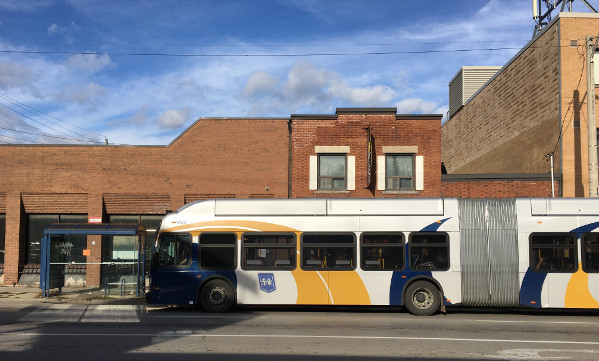
Articulated HSR bus (RTH file photo)
The Hamilton Street Railway (HSR) is Hamilton's transit agency operating its many bus routes. Since the late 1980s, ridership growth on the HSR has stagnated due to decades of transit underfunding by the city. In 2013, ridership was 75 percent of what it was in the late '80s when HSR had 50 percent more buses on the road.
The few routes with high levels of service have had, and continue to have, high ridership, confirming a relationship long known in the transit industry.
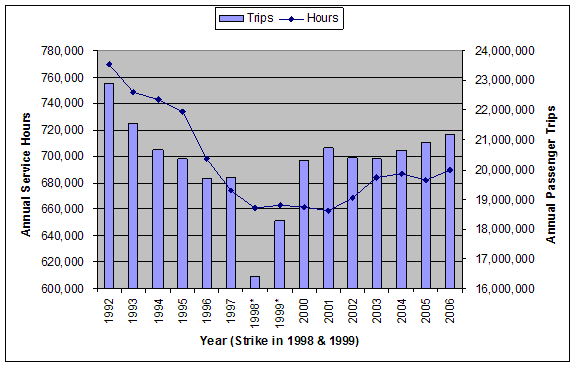
Chart: HSR service hours and ridership, 1992 - 2006 (RTH file image)
In 2006, the Province created a regional transit planning agency for the Greater Toronto and Hamilton Area (GTHA) that adopted the name Metrolinx in 2007. GO Transit was merged into Metrolinx in 2009. Municipalities in the GTHA were asked to put forward major transit initiatives for funding by the Province.
Hamilton's Transportation Master Plan of 2007 led to a proposed five-line LRT network with Hamilton putting forward its downtown east-west LRT (B-Line) as its highest priority, to be followed by a north-south LRT line that would connect downtown Hamilton to the part of the city on the Mountain (A-Line).
The Province's MoveOntario 2020 transit plan of 2007 included Hamilton's B-Line LRT as one of its top 15 projects, these projects becoming part of Metrolinx's 2008 regional transportation plan "The Big Move."
Detailed planning for light rail in Hamilton began with substantial public consultations. A great deal of public support developed during this process. LRT was pictured as more than just higher order rapid transit; it would stimulate revitalization of Hamilton's downtown and other neighbourhoods along the route.
A Metrolinx Benefits Case Analysis of the B-Line LRT was positive. Environmental assessment was concluded in 2011 and the LRT was ready for provincial funding.
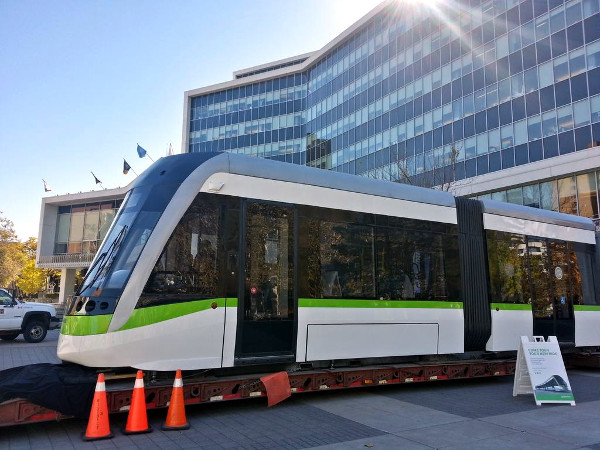
Metrolinx LRT vehicle on display in front of Hamilton City Hall (RTH file photo)
In 2011, Hamilton's LRT project was put into suspended animation by then-Mayor Bob Bratina, elected in the fall of 2010. Bratina represented to the Province that the city's priority was all-day two-way GO train service, not LRT, with the Province responding by moving Hamilton's LRT down in the Metrolinx priority list.
Hamilton's city manager suspended the Rapid Transit Office and established a new team to focus on getting all-day GO rail service.
Delayed construction of LRT had the consequence of giving opponents opportunities to undermine the project, to the distress of the many citizens who had energetically supported it.
Though the new West Harbour GO station opened in July, 2015, just west of the old James Street North GO station it replaced, there still is no all-day two-way GO train service to the city.
In January 2013, Kathleen Wynne became leader of the Ontario Liberal Party, becoming Premier and continuing as Premier with the Liberal election victory in June 2014. In the municipal elections of October 2014, Fred Eisenberger was elected Mayor of Hamilton, having perviously been Mayor between 2006 and 2010.
(Former Mayor Bratina was elected as MP (Liberal) for Hamilton East-Stoney Creek in October 2015. He remains a strong supporter of passenger rail.)
Eisenberger went to bat for LRT and, in May 2015, the Province announced $1 billion in funding for the Hamilton's B-Line LRT. Because it is entirely funded by the province, the B-Line project is in the hands of Metrolinx.
The project has been modified, with the east end of the route cut back from Eastgate Square to Queenston Circle. Instead, there will be a branch off King Street on James Street North to the West Harbour GO station, a segment of the proposed A-Line LRT.
Part of the funds allocated to Hamilton will also be used for a brand new Centennial Parkway GO station in Stoney Creek 9 km east of James Street on the CN railway line to Niagara Falls.
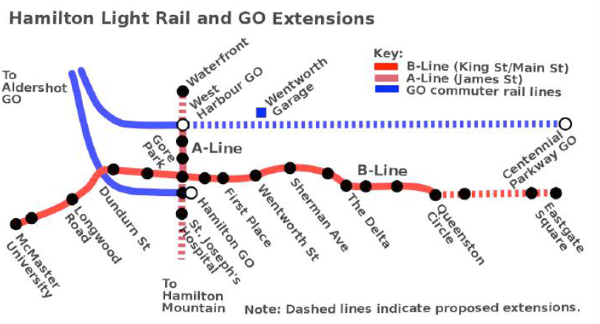
Hamilton LRT and GO Extension Map
HSR will need a garage facility for its 14 light rail vehicles. A likely candidate is a former relatively modern bus garage on Wentworth Street North at the CN rail line, now a City Public Works Department facility.
With modifications, this facility has indoor space to accommodate HSR's LRT fleet. Using this location would require about 2 km of connecting track.
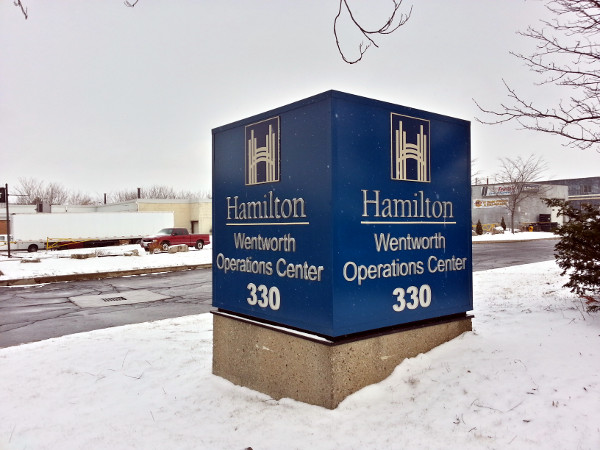
Wentworth Operations Centre, 330 Wentworth Street North (RTH file photo)
In December 2015, Paul Johnson became director of LRT coordination for the City of Hamilton. He is working to expedite LRT construction, starting with utility removal and/or replacement.
As in Kitchener-Waterloo, the construction of the project will be a P3. Contract tendering will occur in 2017, with construction to start in 2019, completion being in 2024.
Johnson has indicated that the A-Line segment to the West Harbour GO station is now being more fully studied. Other parallel streets just either side of James Street may get the track. There may also be room in the budget to take this branch to Waterfront.
With Brampton rejecting an LRT line through its downtown in October 2015, some Hamiltonians are hoping these unspent funds might move to Hamilton. They could be applied to extend the B-Line to Eastgate Square as originally planned, or to extend the A-Line to Waterfront and/or St. Joseph's hospital on James Street South.
While the LRT drama has had a happy ending, drama still surrounds Hamilton's bus-based transit system, in decline for 30 years. Comparable transit systems across Canada have grown ridership by expanding service frequencies and routes. By contrast, City Council in Hamilton has a closed wallet for transit expansion.
It appears to have adopted an unofficial policy of refusing to put more city tax dollars into transit, instead relying on fare increases (which can be counterproductive) and extra money from the Province.
In November 2014, David Dixon, formerly an operations manager with the TTC, became the new director of the HSR. As someone finally willing to push a transit agenda in Steeltown, his arrival in that post was viewed by many Hamilton transit advocates as a breath of fresh air.
Dixon delivered a Ten-Year Transit Strategy [PDF], adopted by City Council in March 2015. The plan was growth-oriented, but Dixon did not ask Council to dip into its municipal pockets.
The plan included fare increases sufficient to provide some new buses and additional drivers. More ambitiously, it called for increased service, especially on routes that have been identified for future LRT.
Out of sync with the Mayor, who was in negotiations with the Province to get Hamilton's LRT funded, Dixon's Ten-Year Transit Strategy called on the Province for a $302 million grant, the first $100 million being for fleet expansion and the rest for a new bus garage. (At present the HSR bus garage and maintenance centre is on the Mountain close to the airport.)
LRT supporters were stunned by this new grant request, which was perceived as putting LRT funding by the Province at risk. But Transportation Minister Steven Del Duca quickly threw cold water on another handout to Hamilton, stating that, instead, Hamilton should make use of the gas tax refund monies that are returned to municipalities across the Province on an annual basis.
In January 2015, Hamilton city council voted to end a transit-only bus lane through downtown Hamilton, a pilot project funded by Metrolinx in October 2013. The vote was 9 in favour of closing the bus lanes to 7 against. The Councillors from wards in which the bus-lane operated supported keeping it. The HSR Ten-Year Transit Strategy, which Council approved, includes extensive use of transit-only lanes.
The way forward for the Ten-Year Transit Strategy should be clear. The gas tax refund by the Province is a case in point. Close to 90 percent of the gas tax money is used for roads, whereas the program was originally intended to be a main source of paying for transit.
Waterloo, for instance, uses half of its gas tax refund for transit.
There is another tax anomaly working against transit expansion, a peculiar property tax policy that Hamilton has followed since amalgamation. Amalgamated Hamilton includes the old high-density city, less dense suburban areas, and rural districts. The property tax includes a transit levy that varies according to location.
The transit levy originally reflected the level of transit service in the city's 17 designated areas. Today, ironically, one consequence is that low tax areas (suburbs) oppose transit expansion because their transit levy would go up with better transit.
Critics point out that property taxes for a city's services and programs ought not be a fee for service, but should rather reflect the cost of services and programs to everyone equally.
Two citizen panels have recommended an end to area weighting for the transit levy. One option is a uniform tax rate with only rural areas being exempted. Transit is the only city service remaining with levies determined by area rating.
The area rating system for transit funding and the lopsided use of the gas tax refund for roads are depriving the HSR of significant revenues it needs to augment service to reduce car-dependency by stimulating a modal shift to transit.
The challenge for Hamilton is to finally fund transit at a level typical of most cities of its size, joining the trend to become more transit oriented.
This article was first published in the Transport Action Ontario Newsletter, January-February 2016. It is republished here with kind permission.
By Noted (anonymous) | Posted March 23, 2016 at 09:13:19
"With Brampton rejecting an LRT line through its downtown in October 2015, some Hamiltonians are hoping these unspent funds might move to Hamilton. "
"In a 10-0 vote Monday evening, Brampton council killed a staff proposal for an LRT tunnel under Main St. that would have cost between $410 million and $570 million. Instead, council decided to move forward on one of two alternative LRT routes north of Steeles Ave., either partially up Main St., then east to a new hospital under construction, on to Queen St. and over to the downtown GO Train station, or up Kennedy Rd. to Queen St., then on to the downtown GO station."
thestar.com/news/gta/2016/03/08/brampton-council-kills-lrt-tunnel-proposal.html
Three-quarters of Brampton's MPPs are Liberal, and the Brampton mayor is a former Liberal cabinet minister. Five of five Mississauga MPPs are Liberal, and the mayor is a former Liberal MP. Somehow suspect that the resources will remain inside of Peel Region.
By Sky (anonymous) | Posted March 23, 2016 at 11:32:11
On the topic of LRT and economic development, can someone pitch the idea to the powers that be that as roads are being dug up and new properties/ developments springing up, that we look at ways to incorporate an underground malls/ paths, even bike paths? I know its wishful thinking but someone should think it, no?
By JZ (anonymous) | Posted March 24, 2016 at 12:26:26
Your reference to gas tax refunds is incorrect. Provincial gas taxes can only be put towards transit (operating or capital)
Hamilton uses federal gas taxes primarily for roads, as this program has broader eligibility criteria.
By Passenger on King (anonymous) | Posted March 24, 2016 at 22:26:04
Heres an IDEA!!!
Maybe all these people with walkers and wheelchairs SHOULD PAY A FARE! this would equal some extra money out instead off the the rest of us blue collar workers paying for them! And maybe when i'm waiting for a bus i will be able to get on instead of the isles allways being full with empty seats all around... AGAIN! the city does not care about the average person!
By Passenger on King (anonymous) | Posted March 24, 2016 at 22:28:07
Back in the day we made 1 way streets to handle more cars.... So you want to add or make an LRT lane GREAT more traffic jams in downtown hamilton. No worries no one goes down there anyways.
By JasonL (registered) | Posted March 24, 2016 at 23:05:21 in reply to Comment 117235
good to know. Everyone not coming down here won't mind one bit as we finally fix up our neighbourhoods.
You must be logged in to comment.
There are no upcoming events right now.
Why not post one?